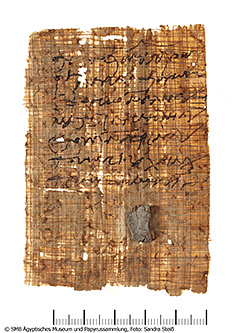SB XII 10907 (P. 13308)
Paying additional duties for the export and import of goods has never been popular and still is not today. However, customs duties are, in addition to taxes, an important source of revenue for the state. A small insight into this area is provided by a papyrus-based customshouse receipt from the Berlin Papyrus Collection.
The papyrus was discovered during the excavations of Friedrich Zucker in Dimeh in the winter of 1909/1910 and shortly afterwards it was added to the Berlin Papyrus Collection. Dimeh is located in the Fayum Oasis near Lake Qarun and is the site of many demotic and Greek papyri. In Greek-Roman antiquity the place was known as Soknopaiou Nesos. This means „Island of the (God) Soknopaios“. Soknopaios was the main god of this place. The first time the place is mentioned is in 240 B.C. It is very likely, however, that the place existed even before that time. Its heyday was in the 1st and 2nd century A.D. Since the beginning of the 20th century, excavations have been taking place there regularly, and since 2001 the Soknopaiou-Nesos-Project of the University of Salento (Lecce) in Italy has been running there.
On the papyrus, the full text of a customshouse receipt for the export of oil and the remainder of a seal have been preserved. The back has not been inscribed. The seven lines of the text follow a fixed formula which is also known from other gate receipts: first the place of the customs station where payment was made is mentioned. This is Soknopaiou Nesos, where the papyrus was found almost 2000 years later. Then follows the type of duty to be paid: the so-called 1/100 duty, where 1% of the value of the exported goods had to be paid. It is interesting that this document does not say exactly how much this is. After that the name of the payer is mentioned. It is called Papeis. As with most people mentioned in the receipts of that time, unfortunately nothing else is known about him. After that it is stated whether the goods are imported or exported. In the case of this text, goods are exported, the type and quantity of which are now specified more precisely: it is 1.5 metretes of oil, which are transported by one donkey. The unit of measurement metretes was used for liquids in ancient times. The quantity indicated here corresponds to just under 60 litres. The document concludes by dating it according to the regnal year of the ruling emperor. In the dating system we use today, it corresponds to the 9 December of the year 120 AD.
Interesting about this receipt is also the well preserved rest of the seal. The seal consists of dark Nile mud and is preserved only incompletely. On the seal you can see a head from the side, which is turned to the right. At the back of the head a band of his wreath is clearly visible, indicating an emperor, and in the front a part of his nose. The person depicted is the Roman Emperor Hadrian, who is also mentioned in the dating formula of the text. He ruled the Roman Empire between 117 and 138 AD. To the left of the head are some Greek letters that can be supplemented to the Greek word for „year“. So the year of government was also indicated on the seal, which is mentioned in the text. In the Berlin papyrus collection there is a second customshouse receipt from the same day for twice the amount of oil exported by a Demas. Nothing more can be seen on the seal affixed there. However, it must have been identical to the seal on this text.
This small and very inconspicuous text may not be particularly interesting on its own, even if it already shows that a customs duty had to be paid for the export of goods from the Fayum. However, together with several hundred other customshouse receipts found in Soknopaiou Nesos, dating from the first to the beginning of the third century AD, it shows that this place was an important transit point for caravans transporting goods from the Fayum through the desert to the oases in the west and even Alexandria and back. Moreover, oil was apparently an important export commodity of the Fayum.



